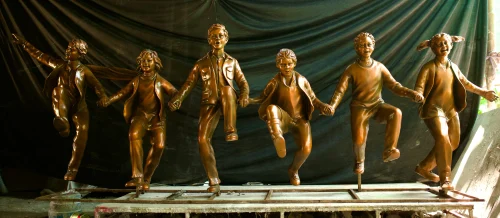Creating spaces that help tickle one’s imagination and playful instincts is essential for the overall development of children. Children’s statues in public areas provide more than just aesthetic appeal. They become a source of creativity and joy. Read on to learn more about the many ways in which these statues contribute to developing a child’s imagination and play. This piece explores the impact of these statues, the different ways they help foster creativity, and how they transform public spaces.
Table of Contents
The Role of Children’s Statues in Public Spaces
Children’s statues are often found in parks, playgrounds, and community areas. They serve as interactive art, inviting children to engage with them creatively. Unlike typical playground equipment, these statues spark stories, games, and curiosity, making children view the world differently.
Stimulating Imagination through Art
A well-crafted statue encourages children to imagine new possibilities. For instance, a statue of a child reading a book can inspire children to create their own stories. They might imagine the character’s background, and adventures, or even join the character on an imaginary journey. These statues stimulate the mind and inspire ideas that go beyond the play space.
Encouraging Role-Playing and Social Interaction
Many children’s statues depict animals, characters, or whimsical creatures. These figures can spark role-playing games where children create scenarios or act out stories with friends. By interacting with the statues, children learn to share, communicate, and play cooperatively. This role-playing helps them develop social skills and fosters emotional intelligence.
Fostering Physical Activity and Exploration
Some statues are specifically designed to be climbable or touchable. These physical elements invite children to explore and move around, combining play with exercise. Statues encouraging climbing, sitting, or even balancing help children use their physical energy positively. This keeps them active and makes playtime more engaging.
Providing Educational Value and Cultural Awareness
Children’s statues sometimes represent historical figures, cultural icons, or important local symbols. These figures offer an opportunity for parents to discuss the stories behind the statues, introducing children to new knowledge. This type of learning can inspire curiosity and provide a connection to history and culture in a child-friendly way.
Design Considerations for Safe and Inclusive Play
To ensure that children’s statues benefit everyone, designers must consider safety, accessibility, and durability. Safety is essential so that children can freely explore the statues without risk. Accessibility ensures that children of all abilities can interact with the statues. Durability is also important since the statues are constantly exposed to weather and frequent handling by children.
Examples of Children’s Statues Inspiring Imagination and Play
Several public spaces use children’s statues to create unique play environments. For example, Kensington Gardens in London has a Peter Pan statue, which invites children into a world of fantasy and adventure. Similarly, Portsmouth Square in San Francisco has animal sculptures acting as play structures and imaginative prompts. These examples highlight how different cities use art to create magical spaces for children.
Involving the Community in the Design Process
When artists and communities work together, they can create statues that resonate with local children. Involving children in the design process can result in statues that reflect their ideas, making these statues more meaningful and engaging. Communities prioritizing this approach help foster a sense of ownership and pride among children, enhancing their connection to public spaces.
Conclusion
Children’s statues are much more than decorations in public spaces. They create opportunities for imaginative play, physical activity, and cultural learning, enriching the lives of children interacting with them. By designing statues that encourage creativity and exploration, communities can help children develop essential skills enjoyably. Public spaces with such art pieces become welcoming and engaging for families, creating environments where children have the independence to imagine and play without boundaries.

